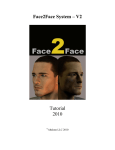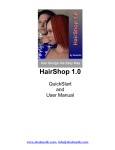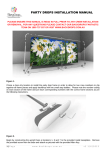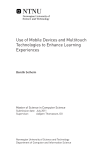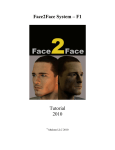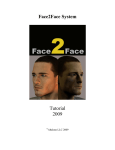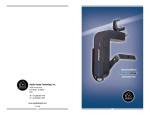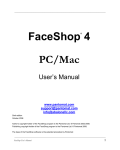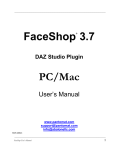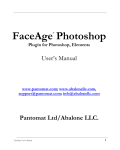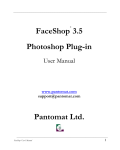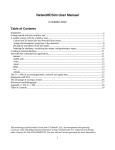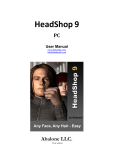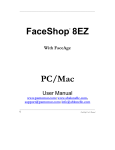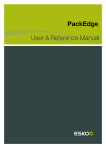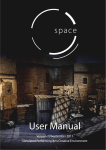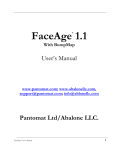Download DressShop 2.0
Transcript
® DressShop 2.0 QuickStart and User Manual www.abalonellc.com, [email protected] Second edition June 2014 Abalone LLC. Author’s copyright holder of the DressShop program is Abalone LLC. ©AbaloneLLC 2013. Publishing copyright holder of the DressShop program is 2013 Abalone LLC . ©AbaloneLLC 2013. Copying, merchandizing, public exhibiting or other commercial utilization of the software without licence is strictly prohibited. The DressShop User’s Manual is under global author and publishing copyright. © 2013 AbalonLLCe. This User’s Manual was written and edited by Laslo Vespremi, Abalone LLC. Copying, extraction or translation to another language is forbidden without the written approval of the holder of this right. Abalone LLC 190 Arbor Lane, Moss Beach CA 94038, USA Web: www.abalonellc.com E-mail: [email protected] ABALONE LLC IS IN NO CASE RESPONSIBLE FOR THE DIRECT OR INDIRECT DAMAGES ARISING FROM THE USAGE OF THE DRESSSHOP PROGRAM OR THE DRESSSHOP USER’S MANUAL. Abalone LLC and the DressShop are the registered trademarks of Abalone LLC Windows is the trademark of Microsoft. About the manual Chapter 1 – QuickStart – Simple Dress Chapter 2 – Advanced Modeling . System requirements Required hardware WIN: DressShop runs with the following minimal hardware: A Windows-based personal computer or laptop with the following minimal requirements: Windows computer 1 GB RAM internal memory TrueColor video card Screen of a resolution 1024x768 250 MB free disk space Needed system software DressShop runs under the following system software: Windows VISTA, WIN7 and WIN8 operating systems. To read pdf manuals Adobe Acrobat is recommended To watch “How-to” videos Windows Media player is recommended: https://www.youtube.com/watch?v=BmCqDtodc-M Installation DressShop is delivered with an installer. To run installer you will need a license key Default installation installs DressShop 2 in the Program Files (x86) folder. Chapter 1. QuickStart – Simple Dress In the following we will describe the steps needed to finish a simple project in DressShop and integrate it with a Genesis figure in DAZ Studio 4.6. Create or find a suitable sketch that will serve as a template for the project. Note: for convenience we have included this photo in the “library” folder. Launch DressShop 2.0 by double-clicking on the DressShop icon. The first time you launch DressShop, a tutorial pane appears. This pane will be shown as long as you don’t click the bottom right checkbox “Do not show this panel again”. If you want to revisit the tut pane again, it can be accessed from the Help menu on the main work screen. Here’s the Browser screen. Step 1. Select image you want to use as a template. Image will appear in the box and the file name displayed below. Step 2. Choose a “Project Name”. Enter project name in the box labeled “Project name”. Step 3. Create a new destination folder. IMPORTANT! This destination folder will contain all files for your new project. Step 4. You may either launch a new project or reopen a saved project. If you chose to reopen a saved project, you need to browse to its location. Press Apply The Selection screen appears Here you need to select one of the two models (Male or Female) 1. Select one of the three basic garment types: Dress, Suit or Cape. In this case click on Dress (default selection). NOTE: these default dresses fit Genesis (V5, M5, V6, etc). If you design for a different model (for example Victoria 4 or a Poser model, you can use the “Import OBJ” to import garments with the right polygon count/rigging for those. Abalone will also make base sets available for a number of non-Genesis models (www.abalonellc.com) 2. Note: the three icons on the right are Manual (?), Video () and About (i).Manual button will launch PDF Manual, Arrow will launch “How-to” video and “i” button will launch About. 3. NOTE: Please see how to export garments from DAZ and Poser to be use with the DressShop “Import” button in the next chapter of this manual on Page 17. Step 5. The main interface opens at Cut Tab (default) The main screen is divided into two halves: 1. Sketch on the left 2. 3D model and Dress in the right. 3. There are five tabs on top: Cut, Shape, Accessories, Materials and Stage. By default program starts with the “Cut” tab. 4. Each tab comes with a set of buttons and tools 5. Navigational controls are all located on the right; on top you have pan, rotate, zoom and center icons (note: if you want to use tools please deselect navigational icons) Below you will find the Fastview cross: Left, Top, Right and Bottom (Back). Get familiar with the screen controls. Click on any of the navigational icons to see how they work. Also, try using the Fastview cross and see how it turns the models 90 degrees. Step 6. Now we start to construct a dress similar to the one in our sketch. Note: You can watch a video of the process under the Help menu (Video Tutorial Part 1 – Cut and Shape). 1. Highlight the garment by clicking on it. It will turn the selected item yellow 2. Select the “Cut” button. 3. Now click the first of two points that describe the straight cut. As we want to cut to be perfectly horizontal, hold the “Shift” key for the second click. This creates a horizontal line. 4. Unclick the “Cut” button. This will finish the cut. 5. Use the delete button to delete the bottom cut-off part Step 8. Highlight the lower cut part (it turns yellow) and click on the “Delete” button. Step 9. Create the “Belt” area 1. Highlight the garment by clicking on it 2. 3. 4. 5. Select “Cut” button This time select polygon tool Holding down the Shift-key create a shape as shown Unclick “Cut” button to finish cut Step 10. Create open neck 1. This time select the “Arc” tool. 2. Place three dots as shown to create arc for the neck shape 3. Click on the “Cut” button to finish cut. Delete excess. Repeat shape to create collar Step 10. Create “Cuffs” 1. This time in addition to “Cut” also click “Mirror” button 2. Create an arc shape for the “cuff” area 3. This will be repeated (mirrored) on the other arm. Step 9. Saving parts to Parts Library 1. Highlight each new part and using the save button save them as collar, leftarm, rightarm, top, belt and skirt into the Parts Library. Note that you can show or hide each part by simply clicking on the checkbox next to their names. 2. Highlight the skirt 3. Using the Duplicate button create a Copy_skirt This concludes the work in the Cut tab – time to move on to the Shape tab! Shape Tab Step 1 Now we will do some basic stretching and shaping! Click on the “Shape” tab on top and unclick the “Shape” button for now. 1. Highlight the garment you want to shape (it will turn yellow). 2. Now click on the “Stretch” button and establish a straight line (holding the Shift-key) from the top of the skirt to the hemline 3. Right click. This will create a rectangle around your centerline. 4. You can stretch this rectangle to the desired shape (here to cover all of the skirt). 5. Using the slider on top you can change the length of the skirt. Here we will make the skirt shorter as shown. Step 2. Use Shape button to shape skirt. Notice that there is a hole on the front of the skirt as it intersects with the skirt below. We need to fix this by shaping the skirt wider 1. Highlight the skirt and select the “Shape button”. 2. Establish a horizontal line at the hemline. 3. Right Click! This will give you a rectangle where you can drag the corners to cover the entire skirt. 4. Using the slider on top shape the skirt wider as shown Accessories Tab. In this tab we will add accessories to the model. Note: You can watch a video of the process under the Help menu (Video Tutorial Part 2 – Accessories and Materials). Step 1. Adding hair to the model 1. Open the “Accessories Library” by clicking on the Open button 2. Choose a female hair and drag it over into the right position 3. Using the side views adjust position until it fits (Use the zoom in tool to see better) Note: You can add your own accessories to the Accessories Library. Simply click on the “Add new” button and browse for saved OBJ files. DAZ Studio users can export these from items they purchased and saved as OBJ files. (It is worth mentioning that export should be set to Custom/0.4) Step 2. Add Belt, Shoes 1. Select “belt” and drag it into position. If size is not correct, you can use slider to adjust 2. Add “leftshoe” and “rightshoe”. Again, care must be taken to make the fit well in all views. Materials Tab. In this tab we will add materials to the model. Note: You can watch a video of the process under the Help menu (Video Tutorial Part 2 – Accessories and Materials). Step 1. Selecting pattern for the top 1. Open Materials Library via the Open button 2. Highlight part you want to pattern 3. Choose a pattern from the library 4. Change size of pattern/angle/transparency as needed Step 2. Select solid colors 1. Select part you want to add color to 2. Click on the white rectangle in the upper right corner of the Materials Library. This will open up an additional color picker 3. Select color and click “Add to Custom Colors”. Click OK 4. In the Material Library click on “Pick Solid Colors”. This will add the color to the part Stage Tab. In this tab we will learn to pose or animate model, create background and take snapshots of our work Note: You can watch a video of the process under the Help menu (Video Tutorial Part 2 – Accessories and Materials). 1. 2. 3. 4. Open Stages Library Notice that some items don’t fit correctly and there may be holes in the garment. By clicking on the “Smoothen” button in 20-50 seconds all problems are fixed. Time to add background Note: as with other libraries, you can add your own backgrounds (jpg format), your own poses and animation in collada format. Step 2. Posing, Snapshot 1. Moving the slider up and down you can alter the pose 2. Take/save a snapshot using the “Photo” button How do I export garments from DAZ (that I want to alter in DressShop 2.0)? Place garment on stage. Make sure that you set all other items (including Genesis or other models “invisible”. Under File/Export choose Wavefront OBJ. Name garment and save it in a folder. Click on “Save”. Next male sure that your export settings are exactly as shown below: Export settings from DAZ Studio How do I export garments from Poser (that I want to alter in DressShop 2.0)? Place garment on stage. Make sure that you set all other. Under File/Export choose Wavefront OBJ. Select “Single Frame” Click OK Make sure you uncheck “Ground” Check the boxes as shown. Click OK. Advanced Modeling The following is an example project where we will discuss some advanced modeling techniques. Feel free to explore and create your own solutions! Our template is a contemporary suit as represented in this sketch. Step 1. Select “Male” and “Suit”. Click “Next”. Step 2. In the “Cut” tab unclick “Cut” button and select (highlight) pants. Click on “Save” button. Save pants under a name, such as “Pants”. This will place the item into your Library. Step 3. Under “Edit” menu open “Library”. By un-clicking the radio button next to “Pants” hide pants. This will prevent you from accidentally cut pants. Step 4. Now using the “Cut” and “Mirror” buttons and the “Arc” tool cut both arms (see previous chapter). Name and save both arms such as “Larm” and Rarm” or similar. Hide both arms. Step 5. Rotate torso to side view and using the “Cut” button and the “StraightLine”’ tool cut a vertical line as shown. Use “Shift key” to constrain second point (end of the line). Name back as “Back” and hide. Step 6. Rotate torso back to front view and using the “Cut” and “Mirror” buttons and the “Polyline” tool cut a shape as shown. Once cut, highlight shape and delete, using the “Delete” button. Step 7. Make all parts visible and open DAZ Studio. . Don’t close DressShop Step 8. In DAZ Studio import the last saved part. Use Bryce as scale. Step 9. Using the “Transfer Utility” dialog under “Edit/Figure” choose the figure (here Genesis) as source and your imported garment name as target. This will fit the garment to the chosen figure. Rotate around to ensure that the garment fits. Step 10. Now go back to DressShop and hide “Back”, “Larm”, “Rarm” and “Pants”. You will create the lapels using the “Cut” and “Mirror” buttons and the “Arc” tool. Once cut is completed, save and name lapels as “Llapel” and “Rlapel” or similar. Step 11. Do the same to cut pockets, using “Cut” and “Mirror” buttons and the “Polyline” tool. Step 12. Save pockets as “Lpocket” and “Rpocket” or similar. Now delete the rest of the jacket and close DressShop. You are done here! Step 13. Import into DAZ Studio the last file you saved. Using the “Transfer Utility” function make this item also fit your figure as shown before. Step 14. Since we want the pockets and lapels slightly offset (in front of the jacket), we will use the “Apply Push Modifier” under “Edit/Figure/Geometry). This will offset (push) these parts in front of the garment. Step 15. In the “Surfacing/Rendering” tab “paint” the jacket and also use a pattern to “paint” the lapels and pockets. Use “Horizontal Tiles” and “Vertical Tiles” sliders to get the pattern right. Finally, pose, light and render! Video: http://www.abalonellc.com/Advanced.wmv





























